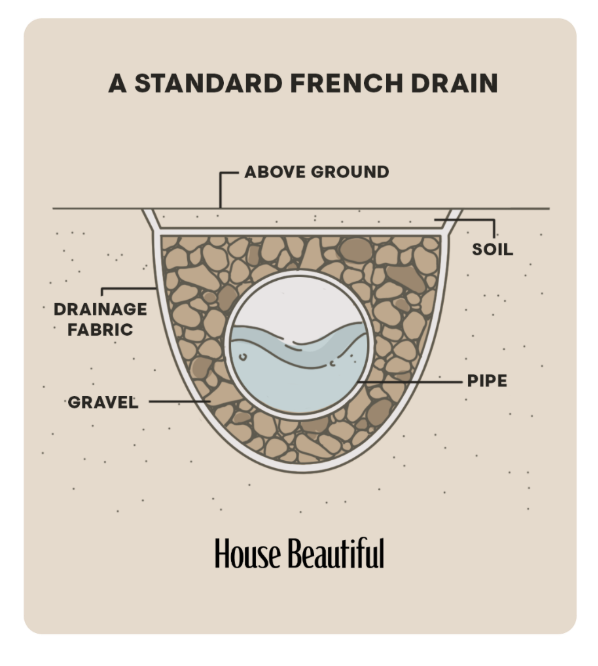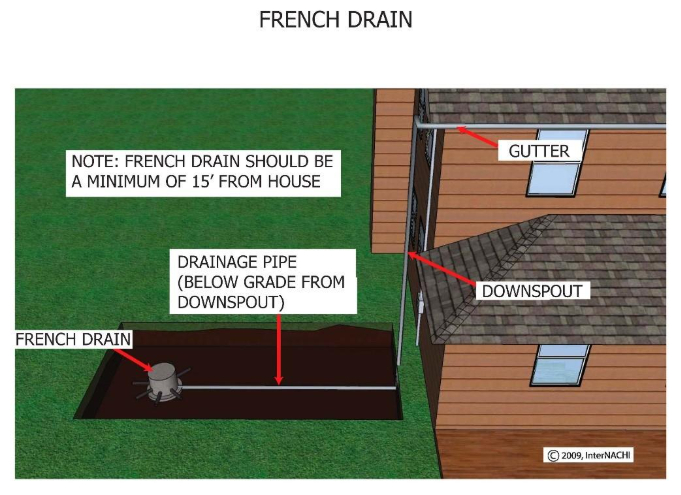Why Every Homeowner Should Know About French Drains and What Problems they can Solve
By: Sean Struckmeyer | Tech Inspect Home Services
Introduction to French Drains:
After we get those big spring rains, is your yard every soggy for days on end? Problems with water seeping into you basement, after a week’s worth of rain?
A solution worth investigating, may be a French drain. In its simplest form a French drain is a gravel filled trench that contains a perforated pipe that is wrapped in landscape or filter fabric. The purpose of this apparatus is to direct water away from a building, a point or area in the yard to a place more suitable for the water to go using gravity.
What Is a French Drain & How It Works
- Anatomy: French Drains are simple, they are made up of a trench, perforated pipe, geotextile filter fabric, gravel, discharge point.

- How it functions: water seeps into trench, filters through gravel, flows through pipe to daylight or dry well. Any water that is left in the pipe, will seep back into the soil around it, once the soil can take on more water.
- The perforated pipe should have a s slope of at least ~1% slope for proper flow. For example, a 15 foot run should drop approx.. 1.8 inches from one end to the other. 0.15 ft × 12 inches/ft = approximately 1.8 inches.
Why You Need A French Drain: Key Problems They Solve
- Standing Water & Pooling – if you have ponding in your yard, standing water or have an overly flat yard, this is a simple, low maintenance way of moving excess water away from that area.
- Foundation Water Damage – waterlogged soil next to the foundation can cause hydrostatic pressures against the foundation which can cause cracking or settlement issues, leading to costly repairs or water infiltration.
- Soil Erosion – slows runoff and preserves topsoil, especially on slopes. By giving the water a place to go (the pipe is hollow)
- Lawn / Plant Health – Any water that does not immediately vacate the drain system, will slowly seep back out into the soil, which can improve water availability for plants, trees or the lawn in the path of the drain system.
Added Value & Lifestyle Perks after Installing a French Drain:
- Landscape Integration & Aesthetics – can be hidden under turf or decorative rock and even planted over. The only ‘visible’ part may be the discharge point. If you have a flat right already, this is a way to keep the yard flat and level while supporting proper drainage.
- Minimal Maintenance & Longevity – low upkeep, durable—often lasting decades nonintrusively, if it’s installed correctly. French drains can clog with dirt and debris, monitoring the drain for effectiveness is an important and should be added to the home maintenance checklist.
- CostEffectiveness – A French drain can be a DIY project and completed in a weekend. While it won’t raise property value, it prevents damage to the foundation and other water related issues. Just remember to call before you dig.
Limitations & When a French Drain Might Not Work
- Not appropriate for completely flat yards or properties with no way to discharge water legally onsite. A large drywell can off-set the ability to daylight a French drain. It’s important to understand how much water the collection system is expected to handle and plan appropriately.
- The drain should be discharged away from the home’s foundation. At least 15 feet. Remember, the idea is to get water AWAY from the house. Collecting it and discharging it all right next to the foundation defeats the purpose.
Design Tips & What to Do Right When Determining the Size and Location of a French Drain
- Sizing: common residential trench is about 8 inches wide and 12-18 inches deep, with 4 in. perforated pipe.
- Proper components: perforated pipe (not solid), nonwoven fabric, correct gravel size (~1½ in. rock), slope of ~1%.
- Discharge planning: connection to dry well, rain garden, daylight slope, or storm drain; avoid sending runoff to neighbor’s property. Dry wells can be purchased or fabricated through DIY means. If you create your own dry well, a 55 gallon plastic barrel is a cheap and readily available option. You can usually find these on Facebook marketplace for about $20.
- Avoid common mistakes per experts: Using the wrong fabric or having the fabric in the wrong place can lead to clogs and reduce the effectiveness of the system. Consider how your drywell discharges, it should be to daylight as well. Consider where the discharge will go and ensure you’re not trading one problem for another.
Conclusion
- French Drains are a centuries old solution to a common problem in managing water. Water will always follow the path of least resistance, so give it a place to go, that works for your property and get it away from the house.
- A poorly designed drain can cause just as many problems as it was intended to solve. This is a fairly straightforward, DIY project, but design is critical and ensuring it’s sized appropriately is equally critical.
- If undertaking a French drain as a DIY project, we recommend plenty of research. They can be installed with a shovel, or you can rent a mini-excavator and make short work of it!
- If you’re having trouble controlling water, having foundation issues or leakage, consider a French drain. Contact your local landscape company for support.
- A French Drain is a common recommendation made in Tech Inspect Home Services Inspection Reports for drainage issues, this represents and effective and low(er) cost solution to many water management problems.
FAQ’s
- How do I know if I should install a French drain? If, you routinely see puddling or standing water in your yard after a heavy rain, then it’s time to consult with a landscape professional to see about a French drain.
- Are French Drains Expensive to install? If you do it yourself it can be relatively cheap with material cost being rock, pipe and cloth.
- Are French Drains hard to install? They can be harder to install depending on the soil and overall layout of the yard. If you have rocky ground or a lot of obstacles or underground utilities it can make installation much harder. Speaking of underground utilities, before you dig call the local utility company and have everything marked.
- Do I need to watch for underground utilities? Yes! While they should generally be buried deeper than you’ll probably need to dig, be sure to have the utilities marked by a locater service and remember those aren’t 100% accurate, you need to allow for variance, plus a few feet on either side.
- Can I use a machine to install the drain? Absolutely! Depending on the size of the project, renting a mini excavator for the day could save you a lot of time! But don’t forget to mark the utilities!!

